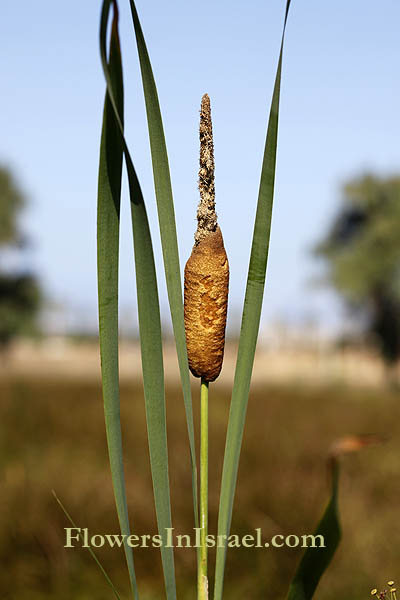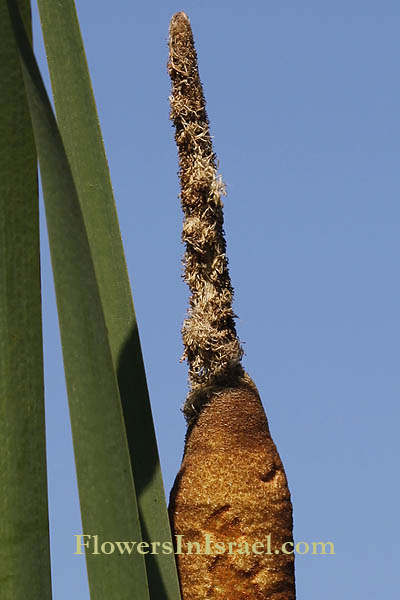Hebrew: סוף רחב-עלים, Arabic: البوط عريض الأوراق
| Scientific name: | Typha latifolia L. | |
| Common name: | Common Cattail, Giant reed-mace | |
| Hebrew name: | סוף רחב-עלים | |
| Arabic name: | البوط عريض الأوراق | |
| Family: | Typhaceae, סופיים |

Location: Netanya, the Dora rain pool |
| Life form: | helophyte | |
| Stems: | Up to 2.5 m in height; erect, stout, unbranched and reed-like | |
| Leaves: | Alternate, rosette, sheath-like leaf, entire, smooth | |
| Flowers: | Terminal, cylindrical, inflorescence in busby-like flowering head = Spadix; female pale green flowers, which produce seeds, are situated towards the bottom of the spadix, the male flowers are located towards the top; male and female regions of the spadix are touching; female flowers tiny, 2-3mm long when in flower, 10-15mm long when in fruit; male flowers, brown, minute, >1.3cm long, thickly clustered, anthers 1-3mm long. | |
| Fruits / pods: | Fruit a tiny, tufted nutlet, blackish brown or reddish brown; seed, minute, numerous. | |
| Flowering Period: | Summer | |
| Habitat: | Humid habitats | |
| Distribution: | Mediterranean Woodlands and Shrublands | |
| Chorotype: | Plurireginalbor-trop | |
| Summer shedding: | Perennating |

Location: Netanya, the Dora rain pool Derivation of the botanical name: Typha, typhos (Greek), "marshes", a name that has been written for these plants since Theophrastus (372-287 BCE) called them tiphe (τὐφη) and Dioscorides (40-80 CE) wrote tiphes (τυφης). ”Typha is linguistically related to Typhon, typhoon, and typhus. These words link four concepts - monsters, storms, diseases, and plants. Typhon, as the father of the Winds, causes dangerous storms. This deity’s name is cognate with “typhoon,” borrowed from the Arabic, Persian, and Urdu وافن tufân (to turn around), and still in use to describe violent cyclonic storms of the Indian Ocean. latifolia, latus,"broad", and folius, "leaf"; hence, "broad leaf"
Because of the Hebrew or Vulgate reference, the Christians of the Middle Ages (500-1500) began using cat-tails in artwork. Typha appears as part of the scenery in the tapestries of unicorns; both plant and animal were allusions to Christ. Paintings by Flemish artist Sir Anthony Van Dyck of Jesus’ mock trial have him with a cat-tail in his hand as a scepter. Even Leonardo da Vinci included Typha. 
Location: Netanya, the Dora rain pool |